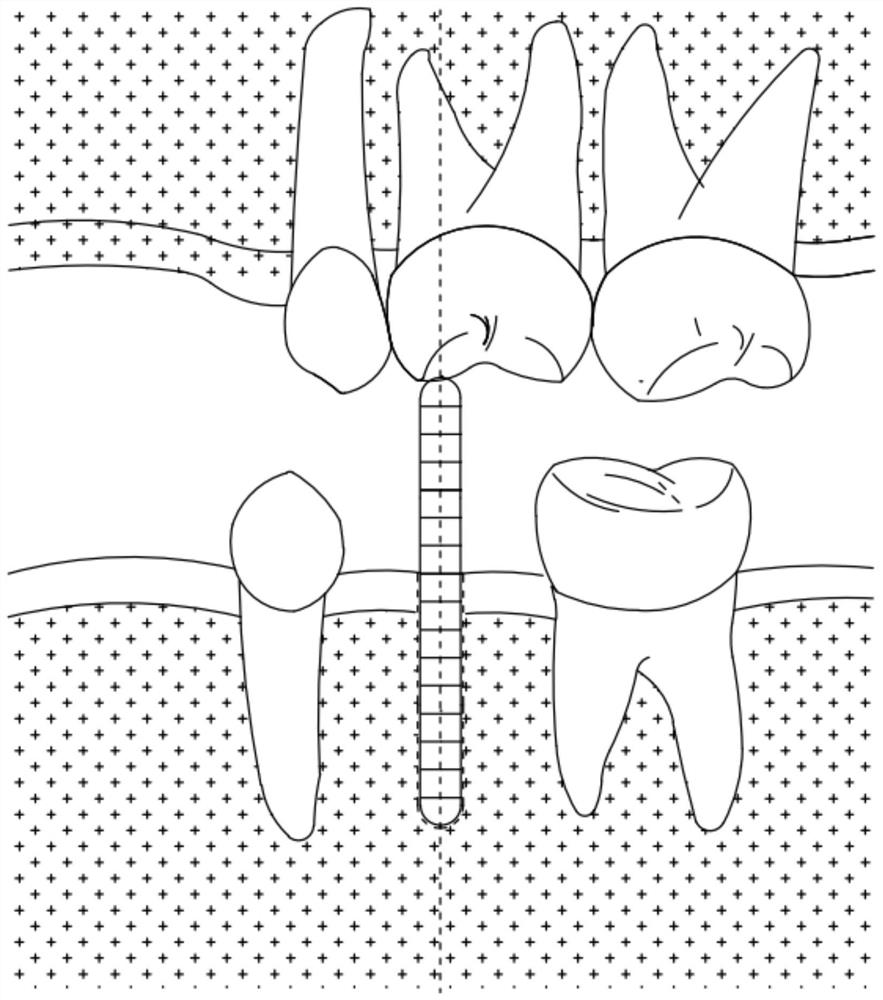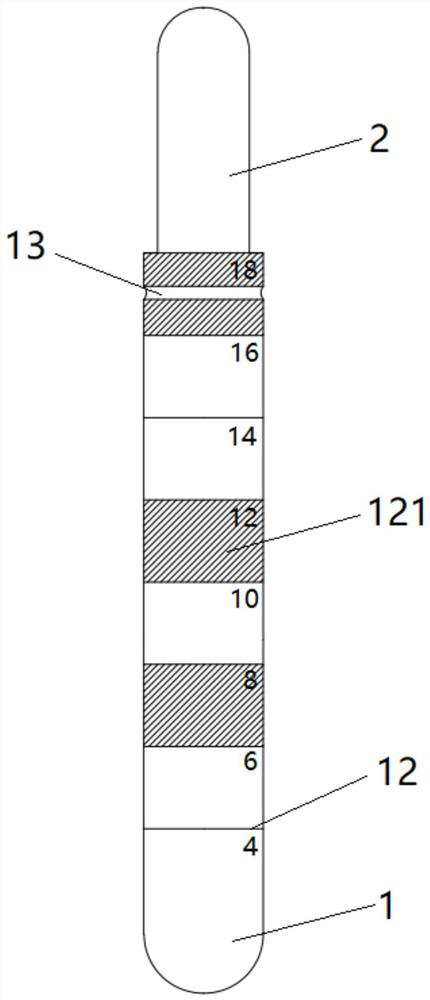Implant cavity measuring rod and method with restoration guidance under tooth tip dislocation as reference
A technique for staggered cusps and implants, which is applied in the field of medical measurement and can solve problems such as obstruction, perforation, and difficulty in taking out.
- Summary
- Abstract
- Description
- Claims
- Application Information
AI Technical Summary
Problems solved by technology
Method used
Image
Examples
Embodiment 1
[0053] As shown in Figure 2 and image 3 As shown, this embodiment provides an implant cavity measuring rod based on the prosthetic guide under the cusp staggered position, which is composed of an intraosseous rod 1 and an occlusal rod 2; 2 is inserted into the hollow cavity 11, so that the central axis of the intraosseous rod 1 and the occlusal rod 2 coincide, and the occlusal rod 2 can slide telescopically in the hollow cavity 11.
[0054] Such as Figure 4 and Figure 5 As shown, during use, one end of the occlusal rod 2 is inserted into the hollow cavity 11 of the intraosseous rod 1 to complete the combination of two rod structures to form a complete measuring rod. Then insert the intraosseous rod 1 into the prepared cavity 3 in the patient's edentulous space, and make one end of the intraosseous rod 1 inserted into the cavity 3 abut against the bottom surface of the cavity 3, and the other end protrude from the opening of the cavity 3, occlusal The rod 2 is telescopica...
Embodiment 2
[0063] In order to alleviate the patient's discomfort during the treatment process and reduce the probability of medical accidents in this implementation, the measuring rod scheme provided in Example 1 has been improved in detail as follows:
[0064] The cavity 3 is a circular hole drilled from the surface of the edentulous space into the bone, and the intraosseous rod 1 and the occlusal rod 2 are both cylindrical rod structures.
[0065] The end surface of the occlusal rod 2 in contact with the occlusal surface 41 of the opposing teeth is rounded to form a convex arc surface.
[0066] The end surface of the intraosseous rod 1 embedded in the cavity 3 is rounded to form a convex arc surface
[0067] Such as figure 2 , image 3 , Figure 4 and Figure 5 As shown, the two rods are set as cylindrical rods, and the surfaces of the two rods in contact with the tissue structure are smoothed, and all the edges and corners of the two rods and the transition of the end faces are r...
Embodiment 3
[0073] This example provides a method for measuring the cavity of an implant based on the prosthetic guide under the cusp interlaced position. The measurement rod scheme described in Example 1 or Example 2 is adopted, and the following steps are implemented to plan the gap between the patient's missing teeth. A 4.8mm diameter implant was placed. Such as Figure 4 and Figure 5 shown.
[0074] Step 1: Before the implant surgery, prepare the pioneer drill bit, the reamer drill bit and corresponding matching multiple measuring rods in advance. Among them, there are two types of Pioneer drills with a diameter of 2.2mm and 2.8mm, and two types of reaming drills with a diameter of 3.5mm and 4.2mm. The diameters of the measuring rods corresponding to each drill bit are 2.2mm, 2.8mm, 3.5mm and 4.2mm respectively.
[0075] Step 2: Select a pioneer drill with a diameter of 2.2mm and assemble it on the drilling machine, and drill a hole at the surgical site in the patient's edentulou...
PUM
| Property | Measurement | Unit |
|---|---|---|
| Diameter | aaaaa | aaaaa |
| Diameter | aaaaa | aaaaa |
| Diameter | aaaaa | aaaaa |
Abstract
Description
Claims
Application Information
 Login to View More
Login to View More - R&D
- Intellectual Property
- Life Sciences
- Materials
- Tech Scout
- Unparalleled Data Quality
- Higher Quality Content
- 60% Fewer Hallucinations
Browse by: Latest US Patents, China's latest patents, Technical Efficacy Thesaurus, Application Domain, Technology Topic, Popular Technical Reports.
© 2025 PatSnap. All rights reserved.Legal|Privacy policy|Modern Slavery Act Transparency Statement|Sitemap|About US| Contact US: help@patsnap.com



